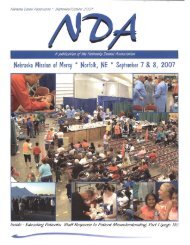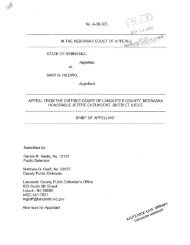Financial Articulation of a Fiduciary Duty to Bondholders with ...
Financial Articulation of a Fiduciary Duty to Bondholders with ...
Financial Articulation of a Fiduciary Duty to Bondholders with ...
Create successful ePaper yourself
Turn your PDF publications into a flip-book with our unique Google optimized e-Paper software.
1986] FIDUCIARY DUTY TO BONDHOLDERS<br />
S<strong>to</strong>ckholder use (or misuse) <strong>of</strong> production/investment<br />
policy frequently involves not some action, but the failure <strong>to</strong><br />
take a certain action (e.g., failure <strong>to</strong> accept a positive net<br />
present value project). Because <strong>of</strong> this, investment policy<br />
can be very expensive <strong>to</strong> moni<strong>to</strong>r, since ascertaining that the<br />
firm's production/investment policy does not maximise the<br />
firm's market value depends on magnitudes which are costly<br />
<strong>to</strong> observe. Solutions <strong>to</strong> this problem are not obvious. For<br />
example, if the indenture were <strong>to</strong> require the bondholders<br />
(rather than the s<strong>to</strong>ckholders) <strong>to</strong> establish the firm's investment<br />
policy, the problem would not be solved; the bondholders,<br />
acting in their self interest, would choose an investment<br />
policy which maximized the value <strong>of</strong> the bonds, not the<br />
20 5<br />
value <strong>of</strong> the firm.<br />
The new fiduciary articulation formalizes the evolutionary separation<br />
<strong>of</strong> corporate management from rank-and-file s<strong>to</strong>ckholder control.<br />
20 6 It benefits employees, communities, and national economic<br />
organization because it implicitly forbids corporate decisions which<br />
increase the risk <strong>of</strong> corporate bankruptcy <strong>with</strong>out correspondingly<br />
20 maximizing 7<br />
the present value <strong>of</strong> the corporation's assets. In<br />
general, it inherently overrides bond protective contractual provisions<br />
because such provisions restrict the corporation's freedom <strong>to</strong><br />
principals (shareholders)," Easterbrook & Fischel, supra note 2, at 1191, concededly<br />
does not apply <strong>to</strong> bondholders because managers are also their agents, see id. at 1195;<br />
and is otherwise overcome by: (a) the rule <strong>of</strong> corporate current-market-value maximization<br />
in which bondholders and s<strong>to</strong>ckholders are interchangeable <strong>with</strong> respect <strong>to</strong><br />
management, and (b) the Black-Scholes conception <strong>of</strong> the corporation in which bondholders<br />
are, in general, the first equitable owners <strong>of</strong> the corporation's assets and cash<br />
flow. The objection regarding "prejudice (<strong>to</strong>] shareholders by decreasing the incentive<br />
<strong>of</strong> management <strong>to</strong> act in their best interest," id. at 1192, is overcome by the express<br />
requirements <strong>of</strong> the new fiduciary articulation. Additional objections regarding unknowable<br />
future decisions by possible takeover successors, how <strong>to</strong> balance possible<br />
gains and losses, etc., see id. at 1190-91, are likewise overcome by the express requirements<br />
<strong>of</strong> the new fiduciary articulation.<br />
205. Smith, Jr. & Warner, supra note 39, at 130 (footnote omitted). Accord W.<br />
KLEIN, supra note 20, at 190 (stating, <strong>with</strong> respect <strong>to</strong> bondholder-s<strong>to</strong>ckholder, common<br />
s<strong>to</strong>ckholder - preferred s<strong>to</strong>ckholder and option/warrantholder - s<strong>to</strong>ckholder corporate<br />
conflicts <strong>of</strong> interest: "There appears <strong>to</strong> be no fully satisfac<strong>to</strong>ry solution <strong>to</strong> the<br />
problem that may be created by this kind <strong>of</strong> prospective conflict .... [I]t appears <strong>to</strong><br />
have received little analytic attention.").<br />
206. See A.A. BARLE & G.C. MEANS, THE MODERN CORPORATION AND PRIVATE<br />
PROPERTY 119-125, 356-57 (1932); Fama, supra note 141, at 290; Jensen & Meckling,<br />
supra note 20, at 343-51, 353. For a review <strong>of</strong> schools-<strong>of</strong>-thought (models) regarding<br />
corporate governance, see Mangrum, In Search <strong>of</strong> a Paradigm <strong>of</strong> Corporate Social Responsibility,<br />
17 CREIGHTON L. REV. 21, 26-49 (1983). The "public interest" model's concern<br />
about the separation <strong>of</strong> corporate ownership and control, see id. at 33 is<br />
theoretically overcome by a "scientific" model (the new fiduciary articulation) which<br />
integrates financial theory <strong>with</strong> the "contract" and "rights" models <strong>of</strong> corporate<br />
governance.<br />
207. See supra notes 71, 73-74 & 192 and accompanying text.








